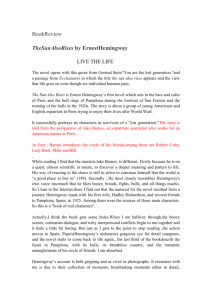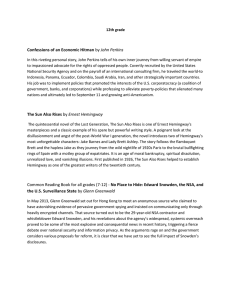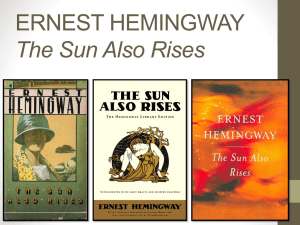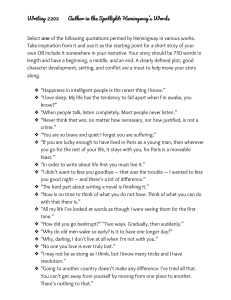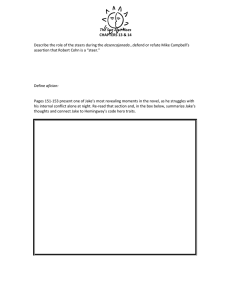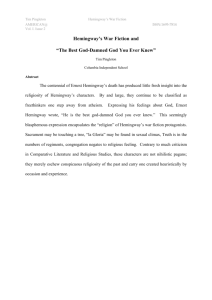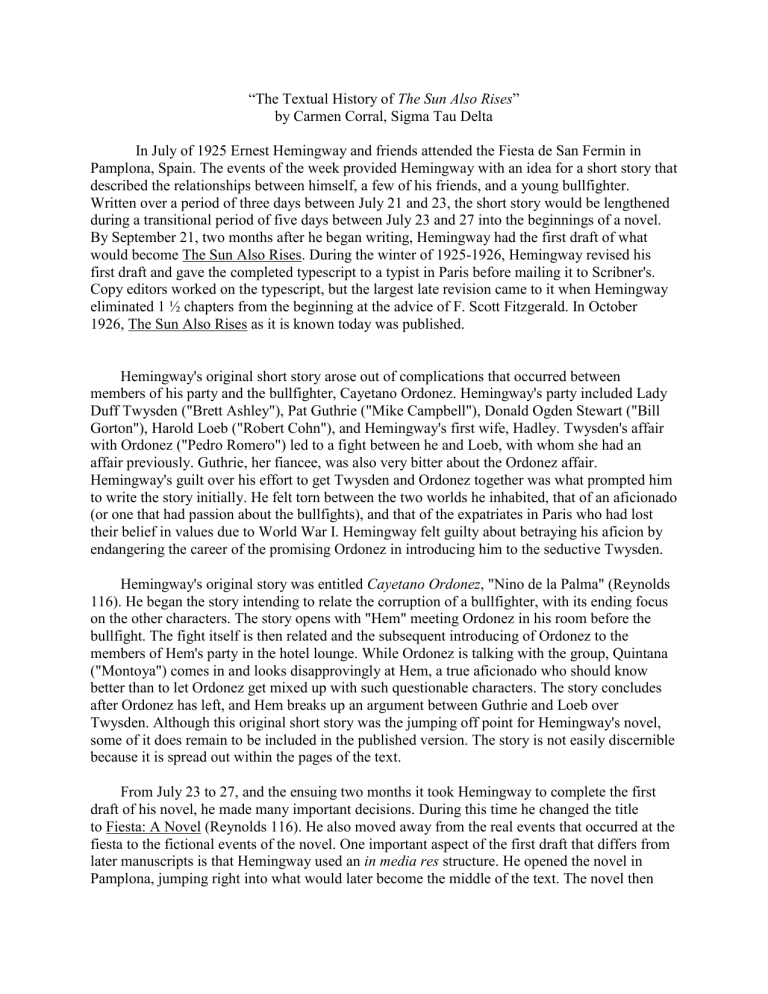
“The Textual History of The Sun Also Rises” by Carmen Corral, Sigma Tau Delta In July of 1925 Ernest Hemingway and friends attended the Fiesta de San Fermin in Pamplona, Spain. The events of the week provided Hemingway with an idea for a short story that described the relationships between himself, a few of his friends, and a young bullfighter. Written over a period of three days between July 21 and 23, the short story would be lengthened during a transitional period of five days between July 23 and 27 into the beginnings of a novel. By September 21, two months after he began writing, Hemingway had the first draft of what would become The Sun Also Rises. During the winter of 1925-1926, Hemingway revised his first draft and gave the completed typescript to a typist in Paris before mailing it to Scribner's. Copy editors worked on the typescript, but the largest late revision came to it when Hemingway eliminated 1 ½ chapters from the beginning at the advice of F. Scott Fitzgerald. In October 1926, The Sun Also Rises as it is known today was published. Hemingway's original short story arose out of complications that occurred between members of his party and the bullfighter, Cayetano Ordonez. Hemingway's party included Lady Duff Twysden ("Brett Ashley"), Pat Guthrie ("Mike Campbell"), Donald Ogden Stewart ("Bill Gorton"), Harold Loeb ("Robert Cohn"), and Hemingway's first wife, Hadley. Twysden's affair with Ordonez ("Pedro Romero") led to a fight between he and Loeb, with whom she had an affair previously. Guthrie, her fiancee, was also very bitter about the Ordonez affair. Hemingway's guilt over his effort to get Twysden and Ordonez together was what prompted him to write the story initially. He felt torn between the two worlds he inhabited, that of an aficionado (or one that had passion about the bullfights), and that of the expatriates in Paris who had lost their belief in values due to World War I. Hemingway felt guilty about betraying his aficion by endangering the career of the promising Ordonez in introducing him to the seductive Twysden. Hemingway's original story was entitled Cayetano Ordonez, "Nino de la Palma" (Reynolds 116). He began the story intending to relate the corruption of a bullfighter, with its ending focus on the other characters. The story opens with "Hem" meeting Ordonez in his room before the bullfight. The fight itself is then related and the subsequent introducing of Ordonez to the members of Hem's party in the hotel lounge. While Ordonez is talking with the group, Quintana ("Montoya") comes in and looks disapprovingly at Hem, a true aficionado who should know better than to let Ordonez get mixed up with such questionable characters. The story concludes after Ordonez has left, and Hem breaks up an argument between Guthrie and Loeb over Twysden. Although this original short story was the jumping off point for Hemingway's novel, some of it does remain to be included in the published version. The story is not easily discernible because it is spread out within the pages of the text. From July 23 to 27, and the ensuing two months it took Hemingway to complete the first draft of his novel, he made many important decisions. During this time he changed the title to Fiesta: A Novel (Reynolds 116). He also moved away from the real events that occurred at the fiesta to the fictional events of the novel. One important aspect of the first draft that differs from later manuscripts is that Hemingway used an in media res structure. He opened the novel in Pamplona, jumping right into what would later become the middle of the text. The novel then flashed back to Paris, and eventually came back to the opening day of the fiesta (Reynolds 123). Hemingway originally began with what was to be a description of his friends. During his description of Twysden he paused when he wrote the sentence, "she still had a certain wonderful vitality" (Balassi 40). This sentence would change the course of the novel. Hemingway went on to provide much background detail about Twysden, after which he found he had changed his approach. At this point Hemingway began to establish Twysden as a central character. It should be mentioned that she is the only character who retains her real name throughout the manuscript (Balassi 41). With the emerging focus on Twysden, Hemingway had the idea of establishing a romantic/love relationship between the narrator, Hem ("Jake"), and Twysden in order to stretch out the conflicts set up in the original story. After the development of Twysden's character, Hemingway begins to expand on the character of the narrator who would become "Jake." An incident of Jake's youth is related in an effort to help explain why he introduced Twysden to Ordonez. When his much idealized uncle dies, Jake's mother informs him that she would rather see her brother dead than smoking, drinking, or gambling, and she feels the same about him. His mother's statement "prejudiced [him] against all her views and moral values" (Balassi 43). As a result of this incident, Jake says he will not judge his friends for their behavior, or say it would be better for Ordonez to be dead rather than associate with his friends. This story, which would have helped explain Jake's actions later in the novel when he does introduce "Brett" to "Romero," is not in the published version. The principal characters having been introduced, Hemingway changes the setting from Pamplona to Paris. His initial writing consisted of a very descriptive account of life in Paris, or more specifically, the cafes and restaurants on the Left and Right Bank. He would shortly after rewrite the section with the intention of introducing "Gerald Cohn," who later became "Robert Cohn." Hemingway planned to make Cohn the "ironic hero." In order to do so, he felt he had to describe Paris because Cohn had lived there for two years (Balassi 46). Here the manuscript begins to closely correspond to the published novel. From Cohn's introduction on, the essential events of the novel remain the same. It should be noted that during the first draft there are several "editorial paragraphs" in which the narrator, initially Hemingway, speaks directly to the reader. These paragraphs are important because they relate Hemingway's feelings about writing at the time of composition. One passage states, "In life people are not conscious of these special moments that novelists build their whole structures on . . . . None of the significant things are going to have any literary signs marking them. You have to figure them out by yourself" (Balassi 44). Statements like this one were included in the first draft because Hemingway wanted to break away from some of his mentors, like Gertrude Stein. He wanted to develop his own theory of writing and not be restrained by the influence of others, specifically their advocacy of "clear restrained writing." The reason this paragraph and others like it were eventually deleted is because Hemingway did end up employing the theory of "restrained writing" (Balassi 45). During revision of the first draft Hemingway made several significant changes to the novel. First of all, he changed the structure from in media res to a chronological narrative. The change functioned in two ways. It made readers "have to sense the importance of lines that have lost their context" and it "creates a compelling sense of inevitability about events in the novel" (Balassi 48). Hemingway's decision to change the structure was due to failed attempts to begin the novel in revision. He tried once to use a first person point of view, and twice third person. He quit each attempt after only a few pages. Hemingway decided on the opening "This is a novel about a lady" (Reynolds 124). This beginning too was deleted in the published version, along with the first 1 ½ chapters at Fitzgerald's suggestion. In the typescript second draft there were four scenes that Hemingway extensively revised. The first was the early love scene between Jake and Brett in Paris. The second is the conversation between Jake and the waiter in Pamplona about the death of Vicente Girones, a peasant gored while running in front of the bulls. The third is the "corrida" scene, the day after Romero is beat up by Cohn. The fourth is the final chapter of the book. In the first scene Hemingway used his iceberg theory to solve difficulty in revising. By the time of publication, the scene was reduced from 109 words to 34. He wanted to relate both the love and pain that existed between Jake and Brett, underscoring the point that emotionally they did love each other. To do so, Hemingway exercised "a restraint in the use of language" which is comparable to the restraints fate has dealt them concerning their relationship, meaning their inability to be together sexually (Svoboda 50-51). In the second scene, Hemingway's problem in revising was one of "fine tuning" to achieve the desired effect. He wanted to "underline the danger of the corrida" and provide a balance to the praising of "the values of the bullring" (Svoboda 50). During revision only four sentences from dialogue were deleted, and the tone of the scene did not change. Hemingway was working to slow the pace of the scene. In order to accomplish this, he used the repetition and insistence of words, and short sentences. For example, a first draft scene referring to the waiter read, ". . . went away and came back with the coffee and milk pots. He poured the milk and coffee from long spouts into the big cup" (Svoboda 57). Here the repetition of coffee and milk are working to slow the scene, but the final published version is even slower: "He went away and came back with the long-handled coffee and milk pots. He poured the milk and coffee. It came out of the long spouts in two streams into the big cup" (Svoboda 57). The retained repetition and division of the original last sentence into two help to slow the scene even more. In the third scene, Hemingway wanted to convey the perfect bullfight. In earlier drafts he had Romero handle the two bulls in the "modern" style, which blemished the overall effect because it was not an act of perfection. In this version of the scene, Romero moves in toward the bull as he goes in for the kill, thus reducing the impending danger to himself. The published version of the scene is different in several ways. First of all, Hemingway employed "fine tuning" as before to existing material, and also followed his iceberg theory. In the description of the bull's charge, he lengthened the details and slowed down the pace of the scene by splitting longer sentences into shorter ones. In constructing Jake's narrative commentary of the scene Hemingway decided to employ the iceberg theory, because to describe each element of the fight would require too much material. Instead the published version reads, "It was not brilliant bullfighting. It was only perfect bull-fighting" (Svoboda 64). A significant change to the scene is the difference in the killing of the bulls. Pedro no longer kills in the "modern" style. Instead he uses the style of the "classic corrida" by not moving toward the bulls, but provoking them to charge. This scene is the one described in the published novel. The fourth scene that Hemingway made significant revisions to is the last chapter of the published novel. He mainly employed the iceberg theory to eliminate much of Jake's "musings" after leaving Pamplona, and excessive dialogue between Jake and Brett. In early drafts Hemingway had Jake sounding more bitter than in the final version. In the published novel, Jake "is more realistic, and he seems to be in better control of his emotions" (Svoboda 81). In other words, at the conclusion of the novel Jake has found a sense of peace after the turbulent preceding weeks. Hemingway revised the final impression given of Brett several times also. In earlier versions she was written as very confident in her decision to quit her involvement with Romero. This portrayal of her would have undermined the point that she did have a real emotional attachment to him, and relegated him to the ranks of her other lovers. Instead, in the final version, Brett is depicted as "less sure of why she has given up Romero" (Svoboda 88). This version makes the point that Brett has changed, but also reinforces her attachment to Jake because he is the one she "confesses" to. It should be noted here that the division into the three books seen in the published version did not occur until the typescript second draft (Svoboda 90). The eventual title given the novel, The Sun Also Rises, was not chosen until the typescript. Hemingway had a list of possible titles in the last of the notebooks used for the first draft. He chose the published title because he wanted to "emphasize the optimistic idea of progress of life's cycle" (Svoboda 106). It should be noted that although Hemingway changed the original title of Fiesta to the one known, British editions of the novel have used the title of Fiesta from its original publication to the present. One last major revision was made to the novel before publication. After it was set in galley proofs at Scribner's, Fitzgerald read a carbon copy and suggested that the first two chapters be omitted, and the novel begin with the opening of chapter three, when Jake meets the prostitute Georgette (Svoboda 98). Hemingway took Fitzgerald's advice partially and deleted most of the first two chapters, about 3500 words, beginning with the introduction of Robert Cohn. After the deletion, Hemingway was not happy about the missing material and tried several times to insert a beginning that explained its disappearance. This attempt was finally given up because "by referring to the cut chapters it merely capsulizes the faults of those chapters" (Svoboda 105). After the very late revision suggested by Fitzgerald the novel was published in October 1926 as it stands today. Works Cited Balassi, William. "The Trail to The Sun Also Rises: The First Week of Writing." Hemingway, Essays of Reassessment. Ed. Frank Scafella. New York: Oxford UP, 1991. Reynolds, Michael S. "False Dawn: A Preliminary Analysis of The Sun Also Rises' Manuscript." Hemingway: A Revaluation Ed. Donald R. Noble. Troy, New York: Whitston Publishing Company, 1983. Svoboda, Frederic Joseph. Hemingway & The Sun Also Rises, The Crafting of a Style. UP of Kansas, 1983.

